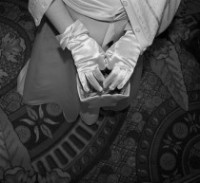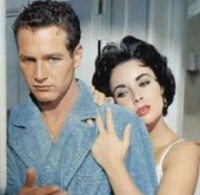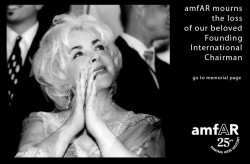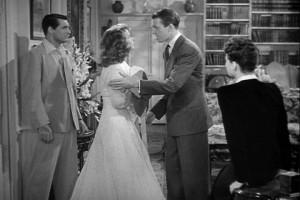How do you say goodnight to a goddess? Do you float up to her gossamer face and place a gentle kiss upon her cheek? Do you flatter her immensely and tell tales of the beauty and grace she bestowed while wishing her a blessed eternal slumber?
Yes, you most certainly do.
Wednesday, the amethyst light winked out of a classic icon’s eyes leaving us with the irrepressible memories and images that she brought to life, reminding us of those she championed for, those she loved and loved her back, and together, we among the many, remember as we watched in wonder as she lit up the movie screen and defined what it is to be a legend.
 Not only have we lost a great actress, a timeless beauty, and a consummate humanitarian, we are ever more witnessing an end to an era. An end to women who never stepped outdoors without their white gloves, or a delicious hatpin, a red, red, lip, or hair so coiffed and perfect that it was an institution. And along with all these glamor trappings, we’re seeing the end to the bawdy dame who mastered refined, regal chic while simultaneously bantering with any man in the room, making him feel as though he is the only one there, whispering conspiratorially with the women in attendance, and turning the heads of just everyone with an infectious laugh, and a well placed hand on an arm. These are things that are not taught, they simply are.
Not only have we lost a great actress, a timeless beauty, and a consummate humanitarian, we are ever more witnessing an end to an era. An end to women who never stepped outdoors without their white gloves, or a delicious hatpin, a red, red, lip, or hair so coiffed and perfect that it was an institution. And along with all these glamor trappings, we’re seeing the end to the bawdy dame who mastered refined, regal chic while simultaneously bantering with any man in the room, making him feel as though he is the only one there, whispering conspiratorially with the women in attendance, and turning the heads of just everyone with an infectious laugh, and a well placed hand on an arm. These are things that are not taught, they simply are.
 Elizabeth’s movies were sumptuous and luscious, full of zeal, verve, and gumption. As Maggie the Cat in Cat on a Hot Tin Roof, you felt every word she spoke, a sultry denizen who held Paul Newman’s Brick in her lustrous gaze, challenging him to love her, despite himself. Butterfield 8‘s Gloria Wandrous was unflappable, desirous, and wore that slip like a powerhouse, rendering us all speechless with the daring topic, and Elizabeth’s delivery. As Who’s Afraid of Virginia Woolf’s, Martha, Elizabeth’s boozy anger, obstinate angst, and treacherous tongue gave as good as she got, undeniably. Her Cleopatra was stunning, classic, omnipresent, and lavish, only a role the Queenly Elizabeth herself could execute. Today, actresses would be hard-pressed to find such varied and dynamic roles, and be able to play them in the same unforgettable way. Simply, there will never be another Elizabeth Rosemond Taylor, two-time Oscar winner, screen royalty, and film legend.
Elizabeth’s movies were sumptuous and luscious, full of zeal, verve, and gumption. As Maggie the Cat in Cat on a Hot Tin Roof, you felt every word she spoke, a sultry denizen who held Paul Newman’s Brick in her lustrous gaze, challenging him to love her, despite himself. Butterfield 8‘s Gloria Wandrous was unflappable, desirous, and wore that slip like a powerhouse, rendering us all speechless with the daring topic, and Elizabeth’s delivery. As Who’s Afraid of Virginia Woolf’s, Martha, Elizabeth’s boozy anger, obstinate angst, and treacherous tongue gave as good as she got, undeniably. Her Cleopatra was stunning, classic, omnipresent, and lavish, only a role the Queenly Elizabeth herself could execute. Today, actresses would be hard-pressed to find such varied and dynamic roles, and be able to play them in the same unforgettable way. Simply, there will never be another Elizabeth Rosemond Taylor, two-time Oscar winner, screen royalty, and film legend.
The English-born owner of lavender eyes, a double row of covetable lashes, and a litany of jewels that would make any monarch envious, the enigmatic Taylor, was also known for her great loves. And yes, she had several. A self-proclaimed romantic, Elizabeth loved falling in love. So much so, that she married the love of her life, and soul-mate, Richard Burton twice. They were “the most famous film star in the world and the man many believed to be the finest classical actor of his generation.” A pairing of giants, they were. And when you love as much, and as often as Elizabeth, there may be a few bumps in the road, or perhaps a wife in your path. Scandal. Oh, dear, yes. The whole Pitt-Aniston-Jolie scandal is nothing compared to that of Elizabeth’s day. If you’re going to do it, do it big, and Elizabeth did just that. She and Eddie Fisher ruled the tabloids in those days, but what else could you really expect from a goddess, right? Aphrodite never apologized.
 When you’re the most beloved Hollywood star in existence what will you do with your retirement? Collect more jewels? Well, maybe. Obtain rare works of art? Certainly. How about found an organization that helps millions of people? Well, if you’re Elizabeth Taylor, naturally. She helped raise more than $100 million to fight AIDS, and after the death of her former costar and friend, Rock Hudson, she co-founded amFAR the American Foundation for AIDS Research, and created her own AIDS foundation, the Elizabeth Taylor Aids Foundation. In 2006, she also commissioned a 37-foot “Care Van” equipped with examination tables and X Ray equipment and donated $40,000 to the New Orleans AIDS task force, a charity designed for the New Orleans population with AIDS and HIV. And remember what I said about being a bawdy dame, yes well, in March 2003, Taylor declined to attend the 75th Annual Academy Awards, due to her opposition to the Iraq war. She publicly condemned then US President George W. Bush for calling on Saddam Hussein to leave Iraq, and said she feared the conflict would lead to “World War III.” Simply, a woman who knows our own heart.
When you’re the most beloved Hollywood star in existence what will you do with your retirement? Collect more jewels? Well, maybe. Obtain rare works of art? Certainly. How about found an organization that helps millions of people? Well, if you’re Elizabeth Taylor, naturally. She helped raise more than $100 million to fight AIDS, and after the death of her former costar and friend, Rock Hudson, she co-founded amFAR the American Foundation for AIDS Research, and created her own AIDS foundation, the Elizabeth Taylor Aids Foundation. In 2006, she also commissioned a 37-foot “Care Van” equipped with examination tables and X Ray equipment and donated $40,000 to the New Orleans AIDS task force, a charity designed for the New Orleans population with AIDS and HIV. And remember what I said about being a bawdy dame, yes well, in March 2003, Taylor declined to attend the 75th Annual Academy Awards, due to her opposition to the Iraq war. She publicly condemned then US President George W. Bush for calling on Saddam Hussein to leave Iraq, and said she feared the conflict would lead to “World War III.” Simply, a woman who knows our own heart.
 For me, when I think of Elizabeth Taylor I also think of that time in Hollywood that was golden and beautiful and full of real movie stars, not the hackneyed, overnight sensations we often find littering Hollywood films today, but women who were sassy and proud, beautiful and fierce, with names like Betty, Lana, Katherine, Audrey, Ava, Rita, Grace, Natalie, and of course, Elizabeth. I adore this time, and watching all of these ladies light up the screen, even in their not so famous roles. My introduction to Elizabeth Taylor wasn’t in National Velvet, it was her turn as sister Amy in 1949’s Little Women, a story I was fascinated with as a young woman. My next favorite was Father of the Bride starring Elizabeth as Kay and Spencer Tracy as Stanley Banks. In addition to her better known, and bigger received films, watching some of the others was like watching her grow into the accomplished actress she became in a career that spanned decades and generations. It’s hard to believe that she was only 79! She has been a fixture in the world for much longer so it seems.
For me, when I think of Elizabeth Taylor I also think of that time in Hollywood that was golden and beautiful and full of real movie stars, not the hackneyed, overnight sensations we often find littering Hollywood films today, but women who were sassy and proud, beautiful and fierce, with names like Betty, Lana, Katherine, Audrey, Ava, Rita, Grace, Natalie, and of course, Elizabeth. I adore this time, and watching all of these ladies light up the screen, even in their not so famous roles. My introduction to Elizabeth Taylor wasn’t in National Velvet, it was her turn as sister Amy in 1949’s Little Women, a story I was fascinated with as a young woman. My next favorite was Father of the Bride starring Elizabeth as Kay and Spencer Tracy as Stanley Banks. In addition to her better known, and bigger received films, watching some of the others was like watching her grow into the accomplished actress she became in a career that spanned decades and generations. It’s hard to believe that she was only 79! She has been a fixture in the world for much longer so it seems.

There is so much you could say about the woman who was. About the woman named for a Queen. A woman who helped millions, entertained millions more, was a teacher in fame, beauty, grace, humility, and undeniable charm. But mostly, we say she was beautiful inside and out, and that will stand the test of time, always.
Goodnight, Dame Elizabeth.



